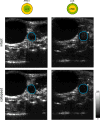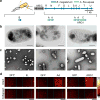Acoustic reporter genes for noninvasive imaging of microorganisms in mammalian hosts
- PMID: 29300010
- PMCID: PMC5920530
- DOI: 10.1038/nature25021
Acoustic reporter genes for noninvasive imaging of microorganisms in mammalian hosts
Abstract
The mammalian microbiome has many important roles in health and disease, and genetic engineering is enabling the development of microbial therapeutics and diagnostics. A key determinant of the activity of both natural and engineered microorganisms in vivo is their location within the host organism. However, existing methods for imaging cellular location and function, primarily based on optical reporter genes, have limited deep tissue performance owing to light scattering or require radioactive tracers. Here we introduce acoustic reporter genes, which are genetic constructs that allow bacterial gene expression to be visualized in vivo using ultrasound, a widely available inexpensive technique with deep tissue penetration and high spatial resolution. These constructs are based on gas vesicles, a unique class of gas-filled protein nanostructures that are expressed primarily in water-dwelling photosynthetic organisms as a means to regulate buoyancy. Heterologous expression of engineered gene clusters encoding gas vesicles allows Escherichia coli and Salmonella typhimurium to be imaged noninvasively at volumetric densities below 0.01% with a resolution of less than 100 μm. We demonstrate the imaging of engineered cells in vivo in proof-of-concept models of gastrointestinal and tumour localization, and develop acoustically distinct reporters that enable multiplexed imaging of cellular populations. This technology equips microbial cells with a means to be visualized deep inside mammalian hosts, facilitating the study of the mammalian microbiome and the development of diagnostic and therapeutic cellular agents.
Conflict of interest statement
The authors declare no competing financial interests. Readers are welcome to comment on the online version of the paper.
Figures















Comment in
-
Ultrasound approach tracks gut microbes.Nature. 2018 Jan 4;553(7686):36-37. doi: 10.1038/d41586-017-08911-0. Nature. 2018. PMID: 29300017 No abstract available.
References
-
- Steidler L, et al. Treatment of murine colitis by Lactococcus lactis secreting interleukin-10. Science. 2000;289:1352–1355. - PubMed
Publication types
MeSH terms
Substances
Grants and funding
LinkOut - more resources
Full Text Sources
Other Literature Sources
Medical
Research Materials

